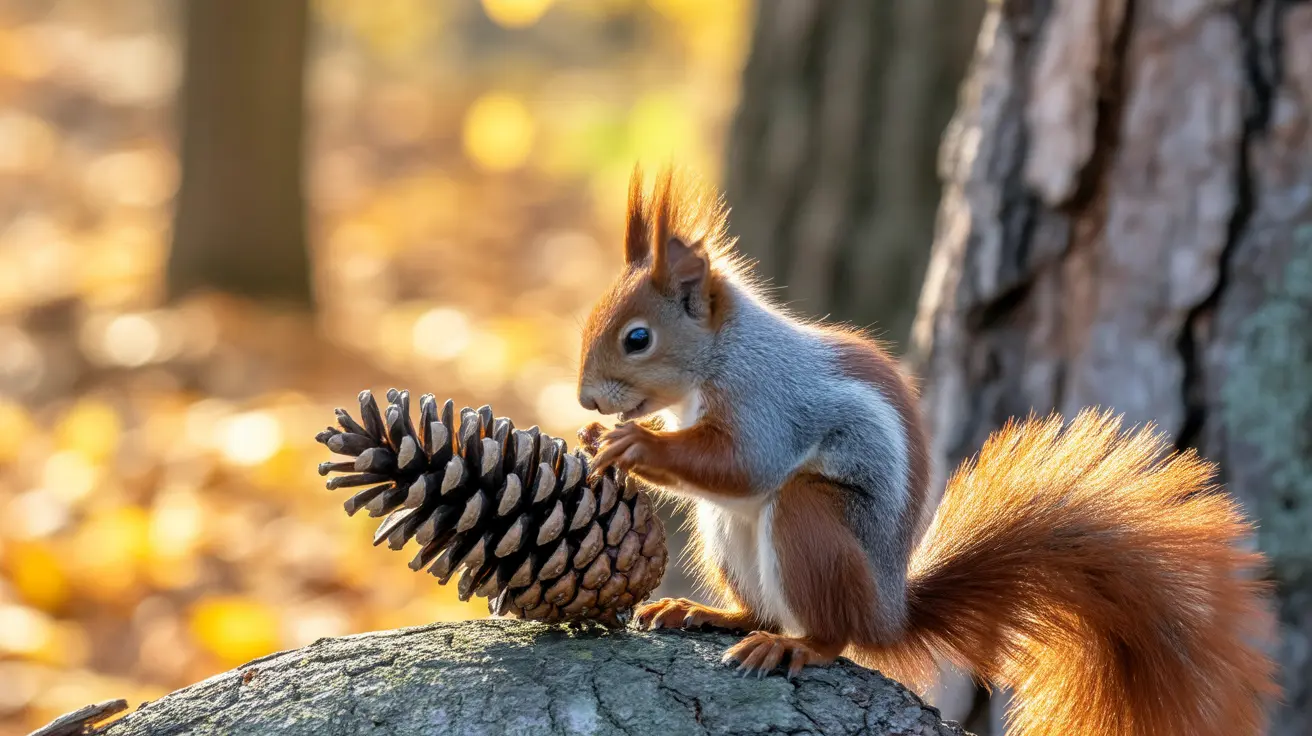As winter approaches, pet owners who enjoy nature walks with their dogs may notice increased wildlife activity around pine trees. Pine cone consumption animals demonstrate fascinating survival strategies that highlight the intricate relationship between forest ecosystems and animal behavior. Understanding these natural foraging patterns can help pet parents better appreciate the wildlife they encounter during outdoor adventures with their companions.
The diversity of what animals eat pine cones reveals remarkable adaptations that have evolved over millions of years. From tiny chipmunks to massive bears, numerous species have developed specialized techniques to access the nutrient-rich seeds hidden within tough pine cone scales. This natural phenomenon offers valuable insights into animal behavior and ecosystem dynamics that every nature-loving pet owner can appreciate.
Squirrels Eating Pine Nuts: Master Foragers of the Forest
Squirrels represent perhaps the most visible example of pine cone consumption animals. These agile creatures possess remarkable dexterity, using their sharp teeth and nimble paws to systematically strip away pine cone scales to reach the seeds inside. Pet owners walking dogs in wooded areas often observe squirrels perched on branches, methodically working through pine cones with practiced efficiency.
The timing of squirrel foraging activity intensifies during late summer and early fall, as these animals prepare for winter months. Their behavior demonstrates excellent planning skills, as they not only consume pine nuts immediately but also cache surplus seeds in various locations throughout their territory.
Chipmunk Foraging Behavior: Nature's Efficient Collectors
Chipmunk foraging behavior showcases one of nature's most efficient collection systems. These small mammals approach pine cone harvesting with systematic precision, often working in the early morning hours when fewer predators are active. Pet owners exercising dogs during dawn hours may witness chipmunks scurrying between pine trees, their cheeks bulging with collected seeds.
Chipmunk Cheek Pouches: Natural Storage Systems
The remarkable adaptation of chipmunk cheek pouches allows these animals to transport multiple pine seeds simultaneously. These expandable pouches can hold up to several dozen seeds, enabling chipmunks to maximize their foraging efficiency during each trip away from their burrows.
Woodpecker Pine Cone Feeding: Specialized Tool Users
Woodpecker pine cone feeding represents one of the most ingenious approaches to accessing pine seeds. These birds have developed unique techniques, wedging pine cones into bark crevices or specialized "anvil" sites to hold them steady while hammering away the tough outer scales with their powerful beaks.
Pet owners may discover evidence of woodpecker activity by finding pine cone remnants scattered beneath certain trees, often in areas where the ground shows clear signs of repeated use as feeding stations.
How Do Animals Crack Pine Cones: Physical Adaptations
The question of how do animals crack pine cones reveals fascinating physical adaptations across species. Different animals employ various strategies based on their anatomical features and behavioral capabilities. Small rodents rely on persistent gnawing with ever-growing incisors, while larger mammals may use brute force or specialized techniques.
Winter Food Storage Rodents and Survival Strategies
Winter food storage rodents demonstrate remarkable foresight in their pine seed collection activities. These animals understand instinctively that pine nuts provide essential fats and proteins necessary for surviving harsh winter conditions when other food sources become scarce.
Bear Diet Pine Nuts: Large-Scale Foraging
Bear diet pine nuts represent a significant seasonal food source for these large mammals in appropriate habitats. When pine nut crops are abundant, bears may travel considerable distances to access these high-energy food sources, demonstrating the important role these seeds play in wildlife nutrition.
Pine Seed Dispersal and Forest Ecosystem Health
Pine seed dispersal through animal consumption creates a mutually beneficial relationship between trees and wildlife. Animals gain nutritional benefits while inadvertently helping forest regeneration through seed transport and burial activities that may result in new tree growth.
Frequently Asked Questions
What animals eat pine cones and how do they access the seeds inside?
Multiple species consume pine seeds, including squirrels, chipmunks, woodpeckers, and bears. These animals use various methods such as gnawing through scales with sharp teeth, wedging cones in bark crevices for leverage, or using brute force to break apart the tough outer layers and access nutrient-rich seeds within.
Why do squirrels and chipmunks collect and store pine cones during fall and winter?
Squirrels and chipmunks cache pine cones and seeds as winter food storage because pine nuts provide essential fats and proteins needed for cold-weather survival. This behavior demonstrates natural planning instincts that help these animals survive when other food sources become unavailable during harsh winter months.
How do chipmunks use their cheek pouches to forage and store pine seeds?
Chipmunk cheek pouches function as natural transport containers, allowing these animals to collect multiple seeds during single foraging trips. The expandable pouches can hold dozens of pine seeds, maximizing collection efficiency and enabling chipmunks to quickly transport food back to their burrows for storage.
Understanding these natural foraging behaviors enriches outdoor experiences with pets while highlighting the remarkable adaptations that allow wildlife to thrive in forest environments. Pet owners can appreciate these fascinating survival strategies during nature walks, gaining deeper respect for the complex relationships that sustain healthy ecosystems.






